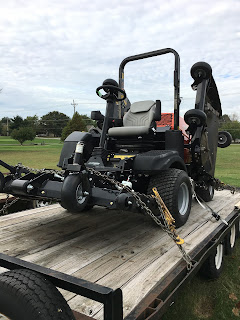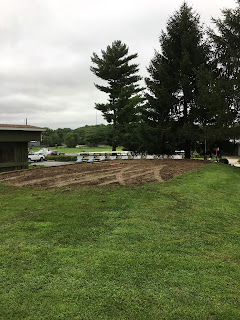This post I would like to share a monthly report I send to my supervisor who compiles reports for our Park Board's monthly meeting. While I have been getting positive feedback, I always wonder, could I improve my reports? Is there something I'm leaving out? I do find some of the research such as weather, rounds, irrigation use, comes in handy when comparing with previous years, I get a better understanding of how the month went. Would love to hear some feedback from you my readers.
Horton Smith Golf Course
Monthly Report
October 2017
Activities: This October we hosted 2,000 rounds of golf. We hosted the last of the Jr. PGA League
matches, and 2 outings. Numbers were a
little lower than last October, but weather was average this year, where in
2016 temperatures averaged 6-7 degrees above average with only a couple of
minor frost delays. We have already had
three 2-hour delays this year, and have had 3 days where the temperature hasn’t
got out of the 40’s.
Weather: This month
we saw average temperatures. Our average
highs were 70.7 degrees, which is 1.7 degrees above the average of 69 degrees in
October. Our monthly average lows
finished at 48 degrees which is 1 degrees above the normal average low of 47
degrees. Precipitation was below average
for this month, we had a total of 2.59” of rain for the month, 1 inch below
average. Rains were evenly spaced.
Maintenance
Practices: While we did continue to set up the course for daily play, this month we
noticed a big decrease in our mowing practices.
Greens still were mowed or rolled daily.
As the month cooled off, we went out to mow less and less, especially
the warm season grass.
Cultural,
Fertilizer and Pesticide Practices: We did verticut and topdress early in the month, but
due to cooling temperatures, we did not topdress later in the month, since
topdressing is based on growth of greens.
We did get in two more Primo applications and one fungicide application
on greens. We also put a pre-emergent
herbicide application on tees. We sliced
and seeded the upper range tee again along with the approaches on 1, 3, 7, and
9. We seeded collars with bentgrass.
Equipment: Equipment has been running well, but we still need
work on our large area rough mower.
Luckily this month, this rough mower became a back-up as we received our
new large area rough mower, a Jacobsen HR600.
After having it out for a couple of weeks, we felt we could lower the
height of cut from 3” it was set to, down to 2.5”, with still good results. We have also noticed that the new mower is
burning ½ gallon less fuel per hour. The
mower averages about 700 hours per season, so we will save 350 gallons of fuel
per season, and it also has an extended service interval compared to the old
mower. The new mower allows for a longer
service interval, we will service the new mower every 200 hours compared to 100
hours on the old mower.


G6-008 as it
arrived at our shop. G6-008 out mowing.
Irrigation: We did use 1,146,645 gallons of water this
month. This was almost identical to what
we used in 2016, (1,464,746 gallons). We
ran 7 different green cycles, 3 tee cycles, and 3 fairway cycles. We had to replace one coil on a head. We had to replace one case that the head was
weeping. We had to repair a plug in a controller. And the main project was to replace the old
electro-mechanical clock in # 10 green control box with an updated retro
kit. The new kit will allow us to water
multiple areas which we couldn’t do before.
We can run a couple of # 10 green heads, while also running some heads
on # 11 tee. The old electro-mechanical
SBM clocks are not that reliable, although they will usually work off the
computer ok. But if we lose that
connection, the timers don’t always work, the station timers could be off up to
maybe 5 minutes or more per station, the hour clocks might not work and start
irrigation cycles on time, or the day dials might not switch over to the next
day. We have about half of the old
electro-mechanical clocks that cannot run by themselves if we were to lose
communications with the computer. Even
when those run ok, we run into issues with the bottom station control panel
with loose plugs. (the clock we did
replace is working well and will become a back-up to other old clocks until we
get them all replaced with the newer Par+ clocks).


The picture on
the left shows the old wire set up. The
picture on the right is the clock. It
can only turn on one station at a time.
The newer clocks can run multiple stations and the newer electronics are
more reliable.
Other Projects:
We did the following projects:
·
Removed a landscape bed on 12/13 and planted grass
seed. Many balls from 12 tee would find
their way into this bed.
·
Installed a new bench on # 18/4 tee.
·
Repaired the wood on other benches.
·
Fixed 8 cart path where roots from a pine tree had heaved
the asphalt.
·
Fixed the equipment wash rack drain, and cleaned up
the area around the wash rack.
·
Mowed down the natural areas.
·
Winterized the irrigation pump house.
·
Winterized some of the ball washers, brought the
rest inside.
·
Wrapped the pipes on the outdoor restrooms to help
protect them from the cold temperature, without having to close them down too
early in the season.
·
Install new lids for irrigation heads with yardage
engraved on them. The heads needed lids
anyway, and these were cheaper then OEM heads.
 The Path on # 8 where the pine
tree roots had damaged the path. We
removed the roots and asphalt, and backfilled with dirty base rock. We will let cart and equipment traffic pack
it solid over the winter and will then come back in and put a layer of concrete
over the patch.
The Path on # 8 where the pine
tree roots had damaged the path. We
removed the roots and asphalt, and backfilled with dirty base rock. We will let cart and equipment traffic pack
it solid over the winter and will then come back in and put a layer of concrete
over the patch.
Wash rack
improvements. It will allow wash water
to drain away, yet we can lift the grates up and scoop up excess grass
clippings.


Well that was our October report. Some of the projects mentioned I want to expand more on in future posts.
Hope I can get some tips to make it better.
Thanks for reading.
Mel























































